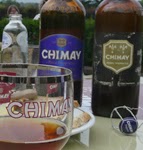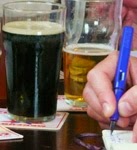Hops A-Z: Q is for Quality and Quantity
As with any crop, agri-economics demands a reasonable rate of return for every hop hectare farmed. Anticipating the level of demand, managing climate and disease factors, optimising production and researching improvements allows hop farmers to maximise yield. Two key questions are; what quantity to produce? And how can quality be optimised?
Let's skip back through recent history. The acreage under hop crop worldwide fell by almost half between 1992 and 2006. Yields declined in the last five years of that period. Hop prices increased and acreage expanded. But then demand fell, leaving a hop surplus in a market whose expected growth has been called 'over-optimisitic' by the hop product and service supplier Barth-Hass. What led to the quantity of hops produced becoming out of sync with market demand?
Germany offers a salutary tale in understanding the hop market's capricious nature. in 2008 the country recorded a record hop harvest, up almost a fifth on the previous year. It made it the largest producer in the world; a third of world hop acreage and almost 40% of alpha-acid production. Over 80% of German hop production is found in the Hallertau region, making it the hop powerhouse of the world - responsible for a quarter of all hops harvested worldwide.
But the demand for such quantity didn't materialise, despite market predictions that hops were 'green gold'. Beer production worldwide has slowed, growing only 1.6% between 2007 and 2008, whilst acreage increased by 13% and crop production by 21%. The trend towards consumers demanding milder beers continued; milder beers need fewer hops. Increased use of isomerised hop products (pellets or extract), which reduce brewer's production costs, reduced the need for whole hops even further.
There's an element of 'more for less' too; if you can increase the quality of a hop variety - more alpha-acid or a consistent quality of aroma - from a crop less susceptible to disease and pests then you need fewer of them.
As the 2008-9 Barth-Hass report says, "there is no point in producing hops for a market that no longer requires them in the quantities anticipated". World hop acreage has started to decline. But whilst growers have one eye on the market, they need to keep an eye on the sky too. In 2009, severe hailstorms tore into the Hallertau region, affecting around 25% of the hop acreage and destroying 5% of it. Given the reduced availability, spot market price rises were seen as inevitable. It's a stark reminder that you can plan and model the market and still be surprised by its actions, but Mother Nature sometimes delivers the greatest shock of all.
Let's skip back through recent history. The acreage under hop crop worldwide fell by almost half between 1992 and 2006. Yields declined in the last five years of that period. Hop prices increased and acreage expanded. But then demand fell, leaving a hop surplus in a market whose expected growth has been called 'over-optimisitic' by the hop product and service supplier Barth-Hass. What led to the quantity of hops produced becoming out of sync with market demand?
Germany offers a salutary tale in understanding the hop market's capricious nature. in 2008 the country recorded a record hop harvest, up almost a fifth on the previous year. It made it the largest producer in the world; a third of world hop acreage and almost 40% of alpha-acid production. Over 80% of German hop production is found in the Hallertau region, making it the hop powerhouse of the world - responsible for a quarter of all hops harvested worldwide.
But the demand for such quantity didn't materialise, despite market predictions that hops were 'green gold'. Beer production worldwide has slowed, growing only 1.6% between 2007 and 2008, whilst acreage increased by 13% and crop production by 21%. The trend towards consumers demanding milder beers continued; milder beers need fewer hops. Increased use of isomerised hop products (pellets or extract), which reduce brewer's production costs, reduced the need for whole hops even further.
There's an element of 'more for less' too; if you can increase the quality of a hop variety - more alpha-acid or a consistent quality of aroma - from a crop less susceptible to disease and pests then you need fewer of them.
As the 2008-9 Barth-Hass report says, "there is no point in producing hops for a market that no longer requires them in the quantities anticipated". World hop acreage has started to decline. But whilst growers have one eye on the market, they need to keep an eye on the sky too. In 2009, severe hailstorms tore into the Hallertau region, affecting around 25% of the hop acreage and destroying 5% of it. Given the reduced availability, spot market price rises were seen as inevitable. It's a stark reminder that you can plan and model the market and still be surprised by its actions, but Mother Nature sometimes delivers the greatest shock of all.





















0 comments: